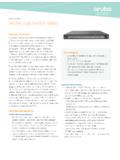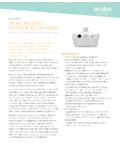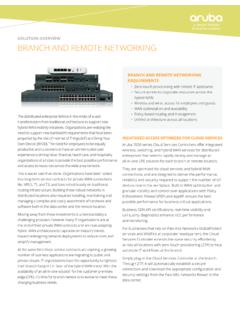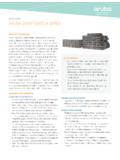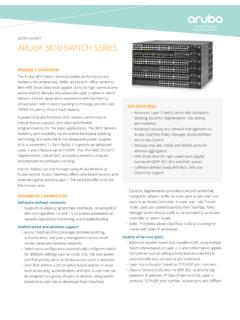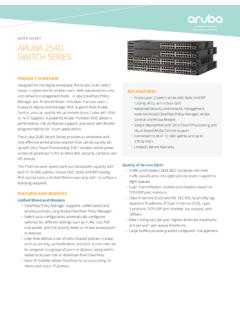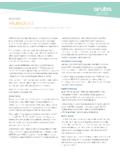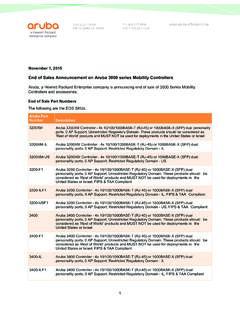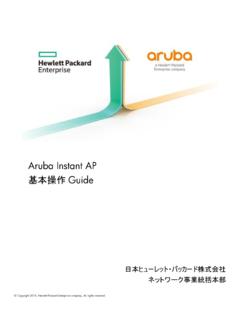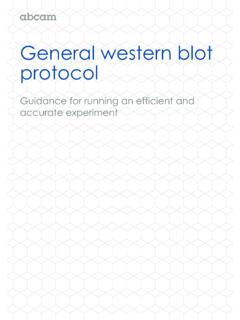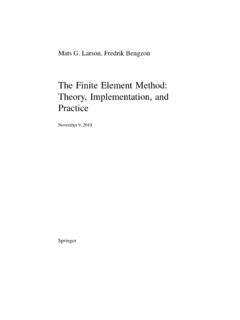Transcription of Aruba 500 Series Wireless Access Points Data Sheet
1 DATA SHEETARUBA 500 Series CAMPUS Access POINTSCost-effective Wi-Fi 6 ( ) for medium-density indoor environmentsThese affordable Wi-Fi 6 Access Points provide high -performance connectivity for any organization experiencing growing numbers of mobile, IoT and mobility requirements. With a combined peak datarate of up to , they deliver the speed and reliability needed for venues and workplaces such as schools, midsize offices and retailers. INCREDIBLE EFFICIENCYThe 500 Series APs are also designed to optimize user experience by maximizing Wi-Fi efficiency and dramatically reducing airtime contention between clients. Features include Orthogonal frequency-division multiple Access (OFDMA), and cellular optimization . With up to 2 spatial streams (2SS) and 80 MHz channel bandwidth (HE80), the 500 Series provides groundbreaking Wireless capabilities for budget-conscious the Multi-User white paper for further of OFDMAThis capability allows Aruba s APs to handle multiple Wi-Fi 6 capable clients on each channel simultaneously, regardless of device or traffic type.
2 Channel utilization is optimized by handling each transaction via smaller sub-carriers or resource units (RUs), which means that clients are sharing a channel and not competing for airtime and bandwidth. WI-FI optimization Client optimization Aruba s patented AI-powered ClientMatch technology eliminates sticky client issues by steering a client to the AP where it receives the best radio signal. Client Match steers traffic from the noisy GHz band to the preferred 5 GHz or 6 GHz band depending on client capabilities. ClientMatch also dynamically steers traffic to load balance APs to improve the user Wi-Fi radio frequency managementTo optimize the user experience and provide greater stability, Aruba AirMatch allows organization to automate network optimization using machine learning.
3 AirMatch provides dynamic bandwidth adjustments to support changing device density, enhanced roaming using an even distribution of Effective Isotropic Radiated Power (EIRP) to radios, and real-time channel assignments to mitigate co-channel AssuranceWith Air Slice, organizations can provide application assurance to their users that goes beyond the traditional capabilities of airtime fairness. After the SLAs are configured, Air Slice monitors network usage, automatically allocates radio resources, and dynamically adjusts radio resources as KEY FEATURES Up to combined peak datarate WPA3 and Enhanced Open security Built-in technology that resolves sticky client issues for Wi-Fi 6 and Wi-Fi 5 devices OFDMA for enhanced multi-user efficiency IoT-ready Bluetooth 5 and Zigbee support Embedded ranging technology for accurate indoor location measurementsDATA Sheet Aruba 500 Series CAMPUS Access POINTS2new users connect.
4 And applications sessions begin or Advanced Cellular Coexistence (ACC)This feature uses built-in filtering to automatically minimize the impact of interference from cellular networks, distributed antenna systems (DAS), and commercial small cell or femtocell Power Monitoring (IPM) Aruba APs continuously monitor and report hardware energy consumption. They can also be configured to enable or disable capabilities based on available PoE power ideal when wired switches have exhausted their power PLATFORM CAPABILITIESThe 500 Series includes an integrated Bluetooth 5 and radio (for Zigbee support) to simplify deploying and managing IoT-based location services, asset tracking services, security solutions and IoT sensors.
5 This allows organizations to leverage the 500 Series as an IoT platform, which eliminates the need for an overlay infrastructure and additional IT resources. Target Wake Time (TWT)Ideal for IoTs that communicate infrequently, TWT establishes a schedule for when clients need to communicate with an AP. This helps improve client power savings and reduces airtime contention with other FOR ACCURATE INDOOR LOCATION Aruba APs act as a foundation for accurate indoor location so that location-aware services can be deployed at scale. Using embedded GPS receivers, Aruba Wi-Fi 6E APs are able to self-locate and work with Wi-Fi 6 APs to establish reference Points that can be used to accurately determine indoor client location. Because they use universal latitude and longitude coordinates, there is no need for custom map development or to create separate applications for indoor and outdoor SECURE INFRASTRUCTUREThe Aruba 500 Series includes components of Aruba s 360 Secure Fabric to help protect user authentication and Wireless traffic.
6 Select capabilities include:WPA3 and Enhanced OpenSupport for stronger encryption and authentication is provided via the latest version of WPA for enterprise protected Open offers seamless new protection for users connecting to open networks where each session is automatically encrypted to protect user passwords and data on guest networks. WPA 2-MPSK MPSK enables simpler passkey management for WPA2 devices should the Wi-Fi password on one device or device type change, no additional changes are needed for other devices. Requires ClearPass Policy PN TunnelsIn Remote AP (RAP) and IAP-VPN deployments, the Aruba 500 Series can be used to establish a secure SSL/IPSec VPN tunnel to a Mobility Controller that is acting as a VPN concentrator.
7 Trusted Platform Module (TPM)For enhanced device assurance, all Aruba APs have an installed TPM for secure storage of credentials and keys, and boot AND SECURE ACCESSTo simplify policy enforcement, the Aruba 500 Series uses Aruba s policy enforcement firewall (PEF) feature to encapsulate all traffic from the AP to the Mobility Controller (or Gateway) for end-to-end encryption and inspection. Policies are applied based on user role, device type, applications, and location. This reduces the manual configuration of SSIDs, VLANs and ACLs. PEF also serves as the underlying technology for Aruba Dynamic Sheet Aruba 500 Series CAMPUS Access POINTS3 HIGH-DENSITY CONNECTIVITYEach 500 Series AP provides connectivity for a maximum of 256 associated clients per radio (512 in total).
8 In real-world scenarios, the maximum recommended client density is dependent on environmental conditions. FLEXIBLE OPERATION AND MANAGEMENTOur unified APs can operate as standalone Access Points or with a gateway for greater scalability, security, and manageability. APs can be deployed using zero touch provisioning without on-site technical expertise for ease of implementation in branch offices and for remote work. Aruba APs can be managed using cloud-based or on-premises solutions for any campus, branch, or remote work environment. As the management and orchestration console for Aruba ESP (Edge Services Platform), Aruba Central provides a single pane of glass for overseeing every aspect of wired and Wireless LANs, WANs, and VPNs.
9 AI-powered analytics, end-to-end orchestration and automation, and advanced security features are built natively into the beamforming (TxBF)Increased signal reliability and rangePasspoint Wi-Fi (Release 2) (Hotspot )Seamless cellular-to-Wi-Fi carryover for guests Dynamic Frequency Selection (DFS)Optimized use of available RF spectrumMaximum Ratio Combining (MRC)Improved receiver performanceCyclic Delay/Shift Diversity (CDD/CSD)Greater downlink RF performanceSpace-Time Block CodingIncreased range and improved receptionLow-Density Parity Check (LDPC)High-efficiency error correction for increased throughputADDITIONAL WI-FI FEATURESEach AP also includes the following standards-based technologies:DATA Sheet Aruba 500 Series CAMPUS Access POINTS4 TECHNICAL SPECIFICATIONSM odelAP-504AP-505 and AP-505 SAP typeIndoor, dual radio, 5 GHz and 2x2 MIMO5 GHz radioTwo spatial stream Single User (SU) MIMO for up to Wireless data rate with 2SS HE80 client radioTwo spatial stream Single User (SU) MIMO for up to 574 Mbps (287 Mbps) Wireless data rate with 2SS HE40 (HE20) client devicesMaximum number of associated client devicesUp to 256 associated client devices per radio Maximum number of BSSIDs16 BSSIDs per radioSupported frequency bands (country-specific restrictions apply)
10 To ISM to U-NII-1 to U-NII-2A to U-NII-2C to U-NII-3/ISMA vailable channelsDependent on configured regulatory domainSupported radio technologies : Direct-sequence spread-spectrum (DSSS) : Orthogonal frequency-division multiplexing (OFDM) : Orthogonal frequency-division multiple Access (OFDMA) with up to 8 resource units Supported modulation types: : BPSK, QPSK, CCK : BPSK, QPSK, 16-QAM, 64-QAM, 256-QAM (proprietary extension) : BPSK, QPSK, 16-QAM, 64-QAM, 256-QAM, 1024-QAM (proprietary extension) : BPSK, QPSK, 16-QAM, 64-QAM, 256-QAM, high-throughput (HT) support:HT20 very high throughput (VHT) support:VHT20/40 high efficiency (HE) support:HE20/40/80 Supported data rates (Mbps): : 1, 2, , 11 : 6, 9, 12, 18, 24, 36, 48, 54 : to 300 (MCS0 to MCS15, HT20 to HT40), 400 with 256-QAM : to 867 (MCS0 to MCS9, NSS = 1 to 2, VHT20 to VHT80), 1,083 with 1024-QAM ( ): to 574 (MCS0 to MCS11, NSS = 1 to 2, HE20 to HE40) (5 GHz): to 1,201 (MCS0 to MCS11, NSS = 1 to 2, HE20 to HE80) packet aggregation:A-MPDU, A-MSDUT ransmit power:Configurable in increments of dBmMaximum (aggregate, conducted total) transmit power (limited by local regulatory requirements) GHz band: +21 dBm (18dBm per chain)5 GHz band: +21 dBm (18 dBm per chain)Note: conducted transmit power levels exclude antenna gain.
